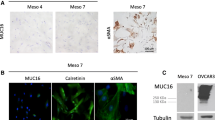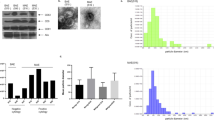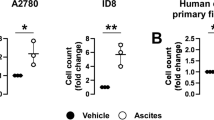Abstract
Purpose
After the seeding ovarian cancer cells into the peritoneal cavity, ascitic fluid creates a microenvironment in which these cells can survive and disseminate. The exact nature of the interactions between malignant ascitic fluids and peritoneal mesothelial cells (HPMCs) in ovarian cancer progression has so far remained elusive. Here we assessed whether malignant ascitic fluids may promote the senescence of HPMCs and, by doing so, enhance the acquisition of their pro-cancerogenic phenotype.
Methods
Primary omentum-derived HPMCs, ovarian cancer-derived cell lines (A2780, OVCAR-3, SKOV-3), malignant ascitic fluids and benign ascitic fluids from non-cancerous patients were used in this study. Ovarian cancer cell proliferation, as well as HPMC proliferation and senescence, were determined using flow cytometry and β-galactosidase assays, respectively. Ovarian cancer cell migration was quantified using a Transwell assay. The concentrations of soluble agents in ascitic fluids, conditioned media and cell lysates were measured using DuoSet® Immunoassay Development kits.
Results
We found that HPMCs, when exposed to malignant ascitic fluids, exhibited decreased proliferation and increased senescence rates. The malignant ascitic fluids were found to contain elevated levels of HGF, TGF-β1 and GRO-1, of which HGF and GRO-1 were able to induce senescence in HPMCs. We also found that HPMCs subjected to malignant ascitic fluids or exogenously added HGF and GRO-1 stimulated ovarian cancer cell progression, which was manifested by an increased production of HA (adhesion), uPA (proliferation), IL-8 and MCP-1 (migration).
Conclusion
Our results indicate that malignant ascitic fluids may contribute to ovarian cancer progression by accelerating the senescence of HPMCs.





Similar content being viewed by others
References
Y. Li, K. Wang, Y. Z. Jiang, X. W. Chang, C. F. Dai, J. Zheng, 2,3,7,8-Tetrachlorodibenzo-p-dioxin (TCDD) Inhibits human ovarian cancer cell proliferation. Cell. Oncol. 37, 429–437 (2014)
M. Momeni, T. Kalir, S. Farag, L. Chuang, D. Fishman, D. E. Burstein, Expression of H1.5 and PLZF in granulosa cell tumors and normal ovarian tissues: a short report. Cell. Oncol. 37, 229–234 (2014)
S. Patel, L. Kumar, N. Singh, Metformin and epithelial ovarian cancer therapeutics. Cell. Oncol. 38, 365–375 (2015)
D. Cvetkovic, Early events in ovarian oncogenesis. Reprod. Biol. Endocrinol. 1, 68 (2003)
F. Odicino, S. Pecorelli, L. Zigliani, W. T. Creasman, History of the FIGO cancer staging system. Int. J. Gynaecol. Obstet. 101, 205–210 (2008)
E. C. Kohn, L. A. Travers, J. Kassis, U. Broome, J. Klominek, Malignant effusions are sources of fibronectin and other promigratory and proinvasive components. Diagn. Cytopathol. 33, 300–308 (2005)
I. Matte, D. Lane, C. Laplante, C. Rancourt, A. Piche, Profiling of cytokines in human epithelial ovarian cancer ascites. Am. J. Cancer Res. 2, 566–580 (2012)
M. R. Simpson-Abelson, J. L. Loyall, H. K. Lehman, J. L. Barnas, H. Minderman, K. L. O'Loughlin, P. K. Wallace, T. C. George, P. Peng, R. J. Kelleher Jr., K. Odunsi, R. B. Bankert, Human ovarian tumor ascites fluids rapidly and reversibly inhibit T cell receptor-induced NF-kappaB and NFAT signaling in tumor-associated T cells. Cancer Immun. 13, 14 (2013)
I. Matte, D. Lane, D. Bachvarov, C. Rancourt, A. Piche, Role of malignant ascites on human mesothelial cells and their gene expression profiles. BMC Cancer 14, 288 (2014)
I. Matte, D. Lane, C. Laplante, P. Garde-Granger, C. Rancourt, A. Piche, Ovarian cancer ascites enhance the migration of patient-derived peritoneal mesothelial cells via cMet pathway through HGF-dependent and -independent mechanisms. Int. J. Cancer 137, 289–298 (2015)
H. A. Kenny, C. Y. Chiang, E. A. White, E. M. Schryver, M. Habis, I. L. Romero, A. Ladanyi, C. V. Penicka, J. George, K. Matlin, A. Montag, K. Wroblewski, S. D. Yamada, A. P. Mazar, D. Bowtell, E. Lengyel, Mesothelial cells promote early ovarian cancer metastasis through fibronectin secretion. J. Clin. Invest. 124, 4614–4628 (2014)
J. Mikula-Pietrasik, P. Sosinska, M. Kucinska, M. Murias, K. Maksin, A. Malinska, A. Ziolkowska, H. Piotrowska, A. Wozniak, K. Ksiazek, Peritoneal mesothelium promotes the progression of ovarian cancer cells in vitro and in a mice xenograft model in vivo. Cancer Lett. 355, 310–315 (2014)
K. Ksiazek, A. Jorres, J. Witowski, Senescence induces a proangiogenic switch in human peritoneal mesothelial cells. Rejuvenation. Res. 11, 681–683 (2008)
K. Ksiazek, J. Mikula-Pietrasik, K. Korybalska, G. Dworacki, A. Jorres, J. Witowski, Senescent peritoneal mesothelial cells promote ovarian cancer cell adhesion: the role of oxidative stress-induced fibronectin. Am. J. Pathol. 174, 1230–1240 (2009)
J. Mikula-Pietrasik, P. Sosinska, E. Naumowicz, K. Maksin, H. Piotrowska, A. Wozniak, D. Szpurek, K. Ksiazek, Senescent peritoneal mesothelium induces a pro-angiogenic phenotype in ovarian cancer cells in vitro and in a mouse xenograft model in vivo. Clin. Exp. Metastasis 33, 15–27 (2016)
K.Ksiazek, Mesothelial cell: a multifaceted model of aging. Ageing Res. Rev. 12, 595–604 (2013)
J. Mikula-Pietrasik, P. Sosinska, J. Janus, B. Rubis, M. Brewinska-Olchowik, K. Piwocka, K. Ksiazek, Bystander senescence in human peritoneal mesothelium and fibroblasts is related to thrombospondin-1-dependent activation of transforming growth factor-beta1. Int. J. Biochem. Cell. Biol. 45, 2087–2096 (2013)
P. Sosinska, J. Mikula-Pietrasik, M. Ryzek, E. Naumowicz, K. Ksiazek, Specificity of cytochemical and fluorescence methods of senescence-associated beta-galactosidase detection for ageing driven by replication and time. Biogerontology 15, 407–413 (2014)
J. Mikula-Pietrasik, A. Kuczmarska, M. Kucinska, M. Murias, M. Wierzchowski, M. Winckiewicz, R. Staniszewski, A. Breborowicz, K. Ksiazek, Resveratrol and its synthetic derivatives exert opposite effects on mesothelial cell-dependent angiogenesis via modulating secretion of VEGF and IL-8/CXCL8. Angiogenesis 15, 361–376 (2012)
K. Lessan, D. J. Aguiar, T. Oegema, L. Siebenson, A. P. Skubitz, CD44 and beta1 integrin mediate ovarian carcinoma cell adhesion to peritoneal mesothelial cells. Am. J. Pathol. 154, 1525–1537 (1999)
C. Bolitho, M. A. Hahn, R. C. Baxter, D. J. Marsh, The chemokine CXCL1 induces proliferation in epithelial ovarian cancer cells by transactivation of the epidermal growth factor receptor. Endocr. Relat. Cancer 17, 929–940 (2010)
K.Fischer, V.Lutz, O.Wilhelm, M.Schmitt, H.Graeff, P.Heiss, T.Nishiguchi, N.Harbeck, H.Kessler, T.Luther, V.Magdolen, U.Reuning, Urokinase induces proliferation of human ovarian cancer cells: characterization of structural elements required for growth factor function. FEBS Lett. 438, 101–105 (1998)
N. Said, M. J. Socha, J. J. Olearczyk, A. A. Elmarakby, J. D. Imig, K. Motamed, Normalization of the ovarian cancer microenvironment by SPARC. Mol. Cancer Res. 5, 1015–1030 (2007)
Y. Wang, J. Yang, Y. Gao, Y. Du, L. Bao, W. Niu, Z. Yao, Regulatory effect of e2, IL-6 and IL-8 on the growth of epithelial ovarian cancer cells. Cell. Mol. Immunol. 2, 365–372 (2005)
Y. Hirashima, H. Kobayashi, M. Suzuki, Y. Tanaka, N. Kanayama, T. Terao, Transforming growth factor-beta1 produced by ovarian cancer cell line HRA stimulates attachment and invasion through an up-regulation of plasminogen activator inhibitor type-1 in human peritoneal mesothelial cells. J. Biol. Chem. 278, 26793–26802 (2003)
S. Furukawa, S. Soeda, Y. Kiko, O. Suzuki, Y. Hashimoto, T. Watanabe, H. Nishiyama, K. Tasaki, H. Hojo, M. Abe, K. Fujimori, MCP-1 promotes invasion and adhesion of human ovarian cancer cells. Anticancer Res. 33, 4785–4790 (2013)
N. Ahmed, K. L. Stenvers, Getting to know ovarian cancer ascites: opportunities for targeted therapy-based translational research. Front. Oncol. 3, 256 (2013)
J. Mikula-Pietrasik, P. Sosinska, K. Maksin, M. G. Kucinska, H. Piotrowska, M. Murias, A. Wozniak, D. Szpurek, K. Ksiazek, Colorectal cancer-promoting activity of the senescent peritoneal mesothelium. Oncotarget 6, 29178–29195 (2015)
G. D'Andrilli, A. Giordano, A. Bovicelli, Epithelial ovarian cancer: the role of cell cycle genes in the different histotypes. Open. Clin. Cancer J. 2, 7–12 (2008)
G. V. Raghuram, P. K. Mishra, Stress induced premature senescence: a new culprit in ovarian tumorigenesis? Indian J. Med. Res. 140(Suppl) S120–S129 (2014)
K. Lohani, S. Shetty, P. Sharma, V. Govindarajan, P.Thomas, B.Loggie, Pseudomyxoma peritonei: inflammatory responses in the peritoneal microenvironment. Ann. Surg. Oncol. 21, 1441–1447 (2014)
S.Judge, P.Thomas, V. Govindarajan, P. Sharma, B. Loggie, Malignant peritoneal mesothelioma: characterization of the inflammatory response in the tumor microenvironment. Ann. Surg. Oncol. 23, 1496–1500 (2016)
C. Frippiat, Q. M. Chen, S. Zdanov, J. P. Magalhaes, J. Remacle, O. Toussaint, Subcytotoxic H2O2 stress triggers a release of transforming growth factor-beta 1, which induces biomarkers of cellular senescence of human diploid fibroblasts. J. Biol. Chem. 276, 2531–2537 (2001)
R. Tremain, M. Marko, V. Kinnimulki, H. Ueno, E. Bottinger, A. Glick, Defects in TGF-beta signaling overcome senescence of mouse keratinocytes expressing v-Ha-ras. Oncogene 19, 1698–1709 (2000)
G. Yang, D. G. Rosen, Z. Zhang, R. C. Bast Jr., G. B. Mills, J. A. Colacino, I. Mercado-Uribe, J. Liu, The chemokine growth-regulated oncogene 1 (Gro-1) links RAS signaling to the senescence of stromal fibroblasts and ovarian tumorigenesis. Proc. Natl. Acad. Sci. USA 103, 16472–16477 (2006)
M. Miyazaki, E. Gohda, K. Kaji, M. Namba, Increased hepatocyte growth factor production by aging human fibroblasts mainly due to autocrine stimulation by interleukin-1. Biochem. Biophys. Res. Commun. 246, 255–260 (1998)
M. Mariani, M. McHugh, M. Petrillo, S. Sieber, S. He, M. Andreoli, Z. Wu, P. Fiedler, G. Scambia, S. Shahabi, C. Ferlini, HGF/c-met axis drives cancer aggressiveness in the neo-adjuvant setting of ovarian cancer. Oncotarget 5, 4855–4867 (2014)
A. Elkhattouti, M. Hassan, C. R. Gomez, Stromal Fibroblast in Age-Related Cancer: Role in Tumorigenesis and Potential as Novel Therapeutic Target. Front. Oncol. 5, 158 (2015)
S. Domcke, R. Sinha, D. A. Levine, C. Sander, N. Schultz, Evaluating cell lines as tumour models by comparison of genomic profiles. Nat. Commun. 4, 2126 (2013)
A. R. Davalos, J. P. Coppe, J. Campisi, P. Y. Desprez, Senescent cells as a source of inflammatory factors for tumor progression. Cancer Metastasis Rev. 29, 273–283 (2010)
Acknowledgments
The study was supported by a grant from the National Science Centre, Poland (registration number 2014/15/B/NZ3/00421). We would like to thank Dr. Eryk Naumowicz from the General Surgery Ward, Centrum Medyczne HCP, Poznań, Poland for providing the omental tissue specimens.
Author information
Authors and Affiliations
Corresponding author
Ethics declarations
Conflict of interest
The authors declare that they have no conflict of interest.
Informed consent
Informed consent was obtained from all individual participants included in the study. The experiments were approved by an institutional ethics committee (consent numbers: 187/14 and 543/14).
Rights and permissions
About this article
Cite this article
Mikuła-Pietrasik, J., Uruski, P., Matuszkiewicz, K. et al. Ovarian cancer-derived ascitic fluids induce a senescence-dependent pro-cancerogenic phenotype in normal peritoneal mesothelial cells. Cell Oncol. 39, 473–481 (2016). https://doi.org/10.1007/s13402-016-0289-1
Accepted:
Published:
Issue Date:
DOI: https://doi.org/10.1007/s13402-016-0289-1




